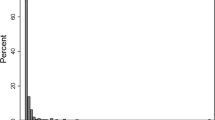Abstract
So-called “three strikes and you're out” sentencing laws for criminal offenders have proliferated in the United States. The laws vary considerably in their definitions of what constitutes a “strike.” This paper adapts the classic Poisson process model of criminal offending to investigate how varying sentence lengths and definitions of what constitutes a strike affect the effectiveness and cost-effectiveness of these sentencing laws. In particular, it asks whether, by using different definitions for the first, second, and third strikes or different sentence lengths, one can make the resulting incarceration more “efficient” in the sense of incapacitating more crimes per cell-year served.
Similar content being viewed by others
REFERENCES
Barnett, A., and Lofaso, A. J. (1986). On the optimal allocation of prison space. In Swersey, A. J., and Ignall, E. (eds.), Delivery of Urban Services, TIMS Series in the Management Sciences, Vol. 22, Elsevier-North Holland, Amsterdam, pp. 249–268.
Blumstein, A., Canela-Cacho, J. A., and Cohen, J. (1993). Filtered sampling from populations with heterogeneous event frequencies. Manage. Sci. 39(7): 886–899.
Chaiken, J. M., and Chaiken, M. R. (1982). Varieties of Criminal Behavior, Report R-2814-NIJ, RAND, Santa Monica, CA.
Chaiken, J. M., and Rolph, J. (1980). Selective incapacitation strategies based on estimated crime rates. Operat. Res. 28: 1259–1274.
Clark, J., Austin, J., and Henry, D. A. (1997). Three Strikes and You're Out: A Review of State Legislation, Research in Brief Series, National Institute of Justice, Washington, DC.
Green, J. R., and Martin, D. N. (1973). Absconding from approved schools as learned behavior: A statistical study. J. Res. Crime Delinq.10:73–86.
Greenberg, D. F. (1990). The cost-benefit analysis of imprisonment. Soc. Just. 17(4): 49–75.
Greenwood, P. W. (with Abrahamse, A.) (1981). Selective Incapacitation, Report R-2815-NIJ, RAND, Santa Monica, CA.
Greenwood, P. W., Rydell, C. P., Abrahamse, A. F., Caulkins, J. P., Chiesa, J., Model, K. E., and Klein, S. P. (1994). Three Strikes and You're Out: Estimated Benefits and Costs of California's New Mandatory Sentencing Law, Mr-509-RC, RAND, Santa Monica, CA.
Greenwood, P. W., Everingham, S. S., Chen, E., Abrahamse, A. F., Merritt, N., and Chiesa, J. (1998). Three Strikes Revisited: An Early Assessment of Implementation and Effects, DRR-1905-NIJ, RAND, Santa Monica, CA.
Maltz, M. D. (1996). From Poisson to the present: Applying operations research to problems of crime and justice. J. Quant. Criminol.12:3–61.
Petersen, E. (1972). The conception of criminality illustrated by a stochastic process model for deviant behavior. J. Res. Crime Delinq.9:31–44.
Rohter, L. (1994). States embracing tougher measures for fighting crime. New York Times May 10: 1.
Shinnar, S., and Shinnar, R. (1975). The effects of the criminal justice system on the control of crime: A quantitative approach. Law Soc. Rev 9(4): 581–611.
Zimring, F. E., Kamin, S., and Hawkins, G. (1999). Crime and Punishment in California: The Impact of Three Strikes and You're Out, Institute of Governmental Studies, Berkeley, CA.
Author information
Authors and Affiliations
Rights and permissions
About this article
Cite this article
Caulkins, J.P. How Large Should the Strike Zone Be in “Three Strikes and You're Out” Sentencing Laws?. Journal of Quantitative Criminology 17, 227–246 (2001). https://doi.org/10.1023/A:1011098100458
Issue Date:
DOI: https://doi.org/10.1023/A:1011098100458




